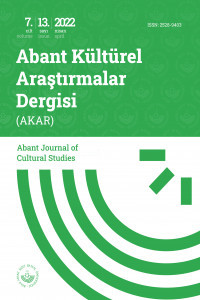Kahramanın Ç hali: Temsil ve özdeşlik bağlamında Behzat Ç. üzerine bir alımlama çalışması
Bu çalışmada, gösterimde olduğu zamanlarda popüler bir medya metni olan Behzat Ç. Bir Ankara Polisiyesi adlı yerli dizide ve bu dizinin sinemadaki uzantıları olan Behzat Ç. Seni Kalbime Gömdüm (2011) ve Behzat Ç. Ankara Yanıyor (2013) adlı filmlerde başkahraman konumunda olan Komiser Behzat Ç. ile izleyici arasındaki özdeşlik ilişkisi sorgulanmıştır. Polis kahramanın temsili, kahramanlık kodları ve kahramanla özdeşlik ilişkisi, Stuart Hall’ün kodlama-kodaçımlama modeli ekseninde çözümlenmiştir. Yarı yapılandırılmış sorular üzerinden on kişiyle derinlemesine görüşmeler yapılmış, böylece bu veriler çerçevesinde izleyicinin bu polisiye anlatıyı nasıl alımladığı ve kahramanla nasıl bir özdeşlik ilişkisi içinde olduğu ortaya konulmaya çalışılmıştır. Yapılan derinlemesine görüşmeler sonucunda, tam anlamıyla klasik anlatı yapısına göre inşa edilmemiş kahramanla izleyici arasında kesin bir özdeşliğin kurulamadığı görülmüştür. İzleyicinin, yaraları olan ve anlatının başından sonuna kadar yaraları dikilmeyen kahramanı genellikle tartışmalı ve eleştirel okuduğu tespit edilmiştir.
Ç case of the hero: A reception study on Behzat Ç. in context of representation and identificatıon
In this study, the identification relationship between the audience and Behzat Ç, a police commissar, who is in the position of the hero in the local TV series named Behzat Ç: Bir Ankara Polisiyesi which was a popular media text when it was broadcasted and the feature film extensions of this TV series named Behzat Ç: Seni Kalbime Gömdüm (2011) and Behzat Ç: Ankara Yanıyor. The representation of the police hero, codes of heroism and the identification relationship with the hero has been analyzed based on Stuart Hall’s encoding-decoding model. Deep interviews have been made with 10 persons over the semistructured interview questions, and it is aimed to show how the audience receives the detective narrative and what kind of an identification relationship with the hero they are. After the deep interviews, it has been seen that there is no certain identification between the audience and the hero, who was not constructed based on the classical narrative structure. The audience seems to read the messages from the negotiated and opposite positions if the hero has scars and if they are not sutured from the beginning to the end of the narrative.
